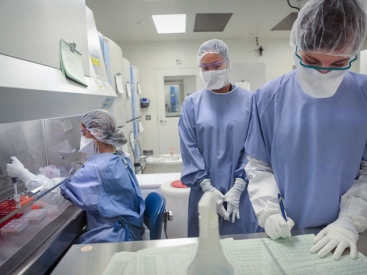Translating Sustainable Cell Engineering
Portability
The potential for engineered blood cells to effectively treat HIV, cancer, and various other maladies holds immense promise. Despite advancements in this field, the cost of this treatment remains prohibitively high- thereby restricting access to patients and research institutions alike. The Adair lab has extensive experience manufacturing engineered blood cells for various applications. Leveraging this experience, we have begun developing multiple tools that can make cell engineering more affordable and accessible for clinical research

Closed-System Cell Processing
Pharmaceutical drug manufacturing must abide by Current Good Manufacturing Practice (cGMP) guidelines which often necessitate a facility with high tech laboratory equipment and millions of dollars in investment. Recent innovations in biotechnological hardware however have made it possible to isolate and culture blood cells within an automated closed system that abides by cGMP guidelines. This type of a machine occupies the space of an ordinary countertop, thus making it highly desirable for portable, point-of-care applications that would dramatically expand access to curative gene therapies. The Adair lab initially developed this technology at Fred Hutch, and is currently expanding its use in regions of clinical need including Africa and India.

Nanoparticles to Deliver Genetic Engineering
The most common method to engineer cells at the level of the DNA is to use engineered viruses. However, engineered viruses are difficult to make and come with risks as they can be detected by the immune system and they can also disrupt the DNA to cause cancer. Newer tools such as CRISPR can be used to edit DNA more safely than engineered viruses, but while engineered viruses naturally enter the cell, CRISPR needs a chaperone to get in. The best chaperone would be one that is cost effective and easy to make, but also works in blood cells including stem cells and immune cells. Over the past 5 years the Adair lab has worked to develop a nanoparticle chaperone to deliver CRISPR into blood cells for genetic engineering. This was a great first step, but much work remains. Current efforts are focused on achieving the levels of genetic engineering required for therapeutic value, improving the nanoparticle design to permit targeting of specific cell types within whole blood or bone marrow, and evaluating the safety of these nanoparticles in appropriate models.
Our hope is to show that these nanoparticles can greatly simplify the process of blood cell engineering, and perhaps even allow for delivery inside the body following an injection.

© 2025 Fred Hutchinson Cancer Center, a 501(c)(3) nonprofit organization.